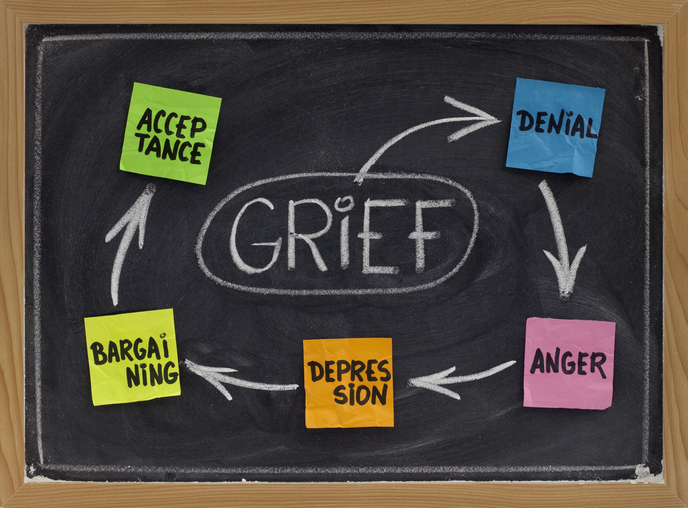
Funeral homes provide ongoing mental health assistance.
“Everyone knows about death, but when it happens to you, it throws everything upside down,” said psychologist Chuck Nechtem of Charles Nechtem Associates, the operator of the Compassion Helpline. A free service available to clients of Dignity Memorial funeral homes 24 hours a day, the Compassion Helpline may be accessed by bereaved family members for up to 13 months and by anyone who signed the memorial visitors’ book for up to three months.
With a presence in the United States and Canada, Dignity Memorial is the largest funeral home company in the world, and the Compassion Helpline is available through every site. “It is hugely used,” said Nechtem. “We get about 500 to 1,000 calls a day concerning grief and related issues.”
Shock is often the first reaction to a death, but its effects can linger. “You’re here but not here,” he said.
Grief is also often accompanied by anxiety and stress. When a person loses a partner, there is often a fear of being alone when the realization hits that life will be restarting without someone who was there before. “People have been losing children more often, and there are suicide and drug issues,” he added. These can lead to depression and desperation. “Grief entails both psychological and physiological issues. Mental health must be a priority.”
Charles Nechtem Associates was founded in 1981 to provide employee assistance programs to various industries and organizations and has since moved into other areas where there is a need for help. Nechtem started the Compassion Helpline approximately 20 years ago when he noticed counselors on helplines being replaced by customer service reps, not trained individuals, he explained.
The Compassion Helpline is staffed by psychologists and social workers, all with Master’s or Doctorate degrees, and every call is answered directly by a counselor.
“There is nobody on hold, no pressing buttons. It is important to have immediate services,” he said. “Counselors are told to stay on the phone as long as necessary. In the event of an apparent risk of suicide or other harm, the counselor will “double-team the call,” staying on the line with the client and carefully seeking location information, while another counselor contacts emergency responders.
Bloomfield-Cooper, a Dignity Memorial funeral home in Manalapan and Ocean Townships in Monmouth County, provides the service to its clients. According to Funeral Director Sue Batko, people who have tried it thought it was “a great service. The majority of phone calls were made in the middle of the night, and the counsellors were compassionate and responsive,” she said
Sue Kleinberg is a contributing writer to Jlife Magazine.
 SIDEBAR
SIDEBAR
Five Stages of Grief
According to the model of the five stages of grief (or the Kübler-Ross model), those experiencing grief go through five emotions: denial, anger, bargaining, depression and acceptance. Although it is in common use, studies have not confirmed these stages, and the model has been criticized as outdated[1] as well as unhelpful in explaining the grieving process.[2][3]
History
The model was introduced by Swiss-American psychiatrist Elisabeth Kübler-Ross in her 1969 book On Death and Dying,[4] and was inspired by her work with terminally ill patients.[5] Motivated by the lack of instruction in medical schools on the subject of death and dying, Kübler-Ross examined death and those faced with it at the University of Chicago’s medical school. Kübler-Ross’s project evolved into a series of seminars which, along with patient interviews and previous research, became the foundation for her book.[6] Although Kübler-Ross is commonly credited with creating stage models, earlier bereavement theorists and clinicians such as Erich Lindemann, Collin Murray Parkes, and John Bowlby used similar models of stages or phases as early as the 1940s.[7]
In her book, Kübler-Ross states that the medical advancements of the time were the mark of change for the way people perceive and experience death. [4] Due to this, pediatricians have been seeing fewer life-threatening ailments for their patients compared to one-hundred years ago.[4]
Kübler-Ross later noted that the stages are not a linear and predictable progression and that she regretted writing them in a way that was misunderstood.[8] “Kübler-Ross originally saw these stages as reflecting how people cope with illness and dying,” observed grief researcher Kenneth J. Doka, “not as reflections of how people grieve.”[9]
As of 2019, On Death and Dying has been translated into forty-one languages, with the 50th anniversary edition being published by Simon & Schuster.
 Stages of grief
Stages of grief
A diagram developed by Bertrand Grondin from a presentation of Kübler-Ross’ ideas produced by France Telecom Diagram showing two possible outcomes of grief or a life-changing event
Kübler-Ross originally developed stages to describe the process patients with terminal illness go through as they come to terms with their own deaths; it was later applied to grieving friends and family as well, who seemed to undergo a similar process.[10] The stages, popularly known by the acronym DABDA, include:[11]
1. Denial – The first reaction is denial. In this stage, individuals believe the diagnosis is somehow mistaken, and cling to a false, preferable reality. Some may also isolate themselves, avoiding others who may have accepted what is happening.[4] This stage is usually a temporary defense, so long as the person has adequate time to move amongst the stages as they contemplate death.[4] In her book, Kübler-Ross states that technological advancements have caused people to become fearful of violent, painful deaths; therefore, in order to protect the psychological mind, they deny the reality of their own inevitable death. [4]
2. Anger – When the individual recognizes that denial cannot continue, they become frustrated, especially at proximate individuals. Certain psychological responses of a person undergoing this phase would be: “Why me? It’s not fair!”; “How can this happen to me?”; “Who is to blame?”; “Why would this happen?”. Some may lash out at loved ones, medical staff, and other family.[4] In Kübler-Ross’s other book, Questions and Answers on Death and Dying, she emphasizes the need for people to do their best to let those who are in this stage feel their feelings and try not to take the anger personally. [12]
3. Bargaining – The third stage involves the hope that the individual can avoid a cause of grief. Usually, the negotiation for an extended life is made in exchange for a reformed lifestyle. People facing less serious trauma can bargain or seek compromise. Examples include the terminally ill person who “negotiates with G-d” to attend a daughter’s wedding, an attempt to bargain for more time to live in exchange for a reformed lifestyle or a phrase such as “If I could trade their life for mine”.
4. Depression – “I’m so sad, why bother with anything?”; “I’m going to die soon, so what’s the point?”; “I miss my loved one; why go on?”
During the fourth stage, the individual despairs at the recognition of their mortality. In this state, the individual may become silent, refuse visitors and spend much of the time mournful and sullen.
5. Acceptance – “It’s going to be okay.”; “I can’t fight it; I may as well prepare for it.”
In this last stage, individuals embrace mortality or inevitable future, or that of a loved one, or other tragic event. People dying may precede the survivors in this state, which typically comes with a calm, retrospective view for the individual, and a stable condition of emotions.
In a book co-authored with David Kessler and published posthumously, Kübler-Ross expanded her model to include any form of personal loss, such as the death of a loved one, the loss of a job or income, major rejection, the end of a relationship or divorce, drug addiction, incarceration, the onset of a disease or an infertility diagnosis, and even minor losses, such as a loss of insurance coverage.[8] Kessler has also proposed “Meaning” as a sixth stage of grief.[13]
In Questions and Answers on Death and Dying, Kübler-Ross answered questions after the publication of her first book, On Death and Dying. She emphasized that no patient should be directly told that they are dying and that practitioners should try to wait until the patient asks about death to discuss it. [12] A few other tenets that she believes in include those practitioners should listen to the patient first and foremost, patient’s right to self-determination should still be practiced, and practitioners should avoid trying to force anything family members and the dying are not in the same stage.[12]
In 2020, during the COVID-19 pandemic, Kessler applied the five stages to responses to the virus, saying: “It’s not a map but it provides some scaffolding for this unknown world.”
“There’s denial, which we saw a lot of early on: This virus won’t affect us. There’s anger: You’re making me stay home and taking away my activities. There’s bargaining: Okay, if I social distance for two weeks everything will be better, right? There’s sadness: I don’t know when this will end. And finally there’s acceptance. This is happening; I have to figure out how to proceed. Acceptance, as you might imagine, is where the power lies. We find control in acceptance. I can wash my hands. I can keep a safe distance. I can learn how to work virtually.”[14]
—Courtesy of Wikipedia
References
1. O’Connor MF (October 2019). “Grief: (stages of grief) A Brief History of Research on How Body, Mind, and Brain Adapt”. Psychosomatic Medicine. 81 (8): 731–738. doi:10.1097/PSY.0000000000000717. PMC 6844541. PMID 31180982.
2. Bonanno G (2009). The Other Side of Sadness: What the New Science of Bereavement Tells Us about Life After Loss. Basic Books. ISBN 978-0-465-01360-9.
3. Stroebe M, Schut H, Boerner K (March 2017). “Cautioning Health-Care Professionals”. Omega. 74 (4): 455–473. doi:10.1177/0030222817691870. PMC 5375020. PMID 28355991.
4. Kübler-Ross E (1969). On Death and Dying. Routledge. ISBN 0-415-04015-9.
5. Broom SM (August 30, 2004). “Milestones”. Time. Archived from the original on February 24, 2009.
6. Perring C. “PHI350: The Stages in the Dying Process”. Retrieved November 27, 2016.
7. Hoy WG (2016). Bereavement groups and the role of social support: integrating theory, research, and practice. New York: Routledge/Taylor and Francis. ISBN 978-1317416357. OCLC 942843686.
8. Kübler-Ross E, Kessler D (2014). On grief & grieving : finding the meaning of grief through the five stages of loss. New York: Scribner. ISBN 978-1476775555. OCLC 863077888.
9. Doka KJ (2016). Grief Is a Journey: Finding Your Path Through Loss. Simon and Schuster. p. 6.
10. Feldman DB (7 July 2017). “Why the Five Stages of Grief Are Wrong”. Psychology Today. Retrieved 15 May 2018.
11. Santrock JW (2007). A Topical Approach to Life-Span Development. New York: McGraw-Hill. ISBN 978-0-07-338264-7.[page needed]
12. Kübler-Ross, Elisabeth (1974). Questions and Answers on Death and Dying. Macmillan. ISBN 0025671200.
13. Kessler D (5 November 2019). Finding Meaning: The Sixth Stage of Grief. Simon and Schuster. ISBN 978-1501192739.
14. Berinato, Scott (23 March 2020). “That Discomfort You’re Feeling Is Grief”. Harvard Business Review. Retrieved 3 July 2020.
15. Kastenbaum R (1998). Death, Society, and Human Experience (6th ed.). Boston: Allyn & Bacon.
16. Corr CA, Doka KJ, Kastenbaum R (1999). “Dying and Its Interpreters: A Review of Selected Literature and Some Comments on the State of the Field”. Omega: Journal of Death and Dying. 39 (4): 239–259. doi:10.2190/3KGF-52BV-QTNT-UBMX. S2CID 145434532.
17. Maciejewski PK, Zhang B, Block SD, Prigerson HG (February 2007). “An empirical examination of the stage theory of grief”. JAMA. 297 (7): 716–723. doi:10.1001/jama.297.7.716. PMID 17312291.
18. Bonanno GA, Boerner K (June 2007). “The stage theory of grief”. JAMA. 297 (24): 2693, author reply 2693-4. doi:10.1001/jama.297.24.2693-a. PMID 17595267.
19. Weiner JS (June 2007). “The stage theory of grief”. JAMA. 297 (24): 2692–93, author reply 2693-4. doi:10.1001/jama.297.24.2692-b. PMID 17595265.
20. Silver RC, Wortman CB (June 2007). “The stage theory of grief”. JAMA. 297 (24): 2692, author reply 2693-4. doi:10.1001/jama.297.24.2692-a. PMID 17595266.
21. Prigerson HG, Maciejewski PK (December 2008). “Grief and acceptance as opposite sides of the same coin: setting a research agenda to study peaceful acceptance of loss”. The British Journal of Psychiatry. 193 (6): 435–437. doi:10.1192/bjp.bp.108.053157. PMID 19043142.
22. Bonanno GA (January 2004). “Loss, trauma, and human resilience: have we underestimated the human capacity to thrive after extremely aversive events?” (PDF). The American Psychologist. 59 (1): 20–28. doi:10.1037/0003-066X.59.1.20. PMID 14736317.
23. Stix G (March 2011). “The neuroscience of true grit”. Scientific American. 304 (3): 28–33. Bibcode:2011SciAm.304c..28S. doi:10.1038/scientificamerican0311-28. PMID 21438486.
24. Konigsberg RD (January 29, 2011). “New Ways to Think About Grief”. Archived from the original on January 31, 2011. Retrieved 27 November 2016 – via www.time.com.
25. Corr CA (23 October 2018). “The ‘five stages’ in coping with dying and bereavement: strengths, weaknesses and some alternatives”. Mortality. 24 (4): 405–417. doi:10.1080/13576275.2018.1527826. S2CID 149545381.
26. Stroebe MS, Schut H (2001). “Models of coping with bereavement: A review”. In Stroebe MS, Hansson RO, Stroebe W, Schut H (eds.). Handbook of bereavement research: Consequences, coping, and care. Washington, DC: American Psychological Association Press. pp. 375–403.
27. Shermer M (1 November 2008). “Five Fallacies of Grief: Debunking Psychological Stages”. www.scientificamerican.com. Scientific American. Archived from the original on 11 May 2020. Retrieved 29 December 2016.
28. Wortman CB, Silver RC (June 1989). “The myths of coping with loss”. Journal of Consulting and Clinical Psychology. 57 (3): 349–357. doi:10.1037/0022-006x.57.3.349. PMID 2661609.






